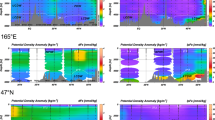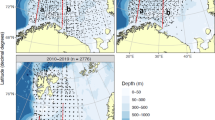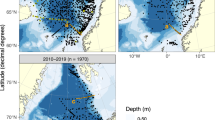Abstract
CONSIDERABLE uncertainties still exist as to the abundances of most of the trace metals in seawater, including some of the more intensively investigated elements. Recent analyses of copper in surface waters south of New Zealand1 and in waters from various depths over the East Pacific Rise2 have given values of 0.06–0.40 µg l−1, and a similar range has been found by M. J. McCartney (personal communication) for samples from the Mediterranean Sea and the northeastern Atlantic Ocean. A geometric mean concentration of 0.26 µg l−1 has been reported for samples collected off the shelf west of Scotland3. These values are either below or at the lower end of the ranges reported for seawater by other workers. For example, extensive measurements4 of dissolved copper in surface waters have given average concentrations for various near-shore and open ocean regions which vary between 0.3 and 1.7 µg 1−1, with a mean of 0.8 µg l−1, and a number of other recent investigations5–8 of North Atlantic Ocean waters also support an abundance value of ∼ 1 µg 1−1. These contrasting findings may reflect real environmental variability but the alternative explanation that such variations are, at least in part, attributable to analytical problems, and especially to contamination, must also be considered. This communication reports values for dissolved copper in samples taken from the eastern Atlantic Ocean in October and November, 1975, which support findings of concentrations of ∼ 0.2 µg l−1. The results of measurements on these samples of the organically associated copper are summarised.
This is a preview of subscription content, access via your institution
Access options
Subscribe to this journal
Receive 51 print issues and online access
$199.00 per year
only $3.90 per issue
Buy this article
- Purchase on Springer Link
- Instant access to full article PDF
Prices may be subject to local taxes which are calculated during checkout
Similar content being viewed by others
References
Boyle, E., and Edmond, J. M., Nature, 253, 107–109 (1975).
Boyle, E. A., and Edmond, J. M., in Analytical Methods in Oceanography (edit. by Gibb, T.R. P., Jr), 44–55, Adv. Chem. Ser., 147 (American Chemical Society, Washington, DC, 1975).
Preston, A., Jefferies, D. F., Dutton, J. W. R., Harvey, B. R., and Steele, A. K., Environ. Pollut., 3, 69–82 (1972).
Chester, R., and Stoner, J. H., Mar. Chem., 2, 17–32 (1974).
Spencer, D. W., and Brewer, P. G., Geochim. cosmochim. Acta., 33, 325–339 (1969).
Brewer, P. G., Spencer, D. W., and Robertson, D. E., Earth planet. Sci. Lett., 16, 111–116 (1972).
Riley, J. P., and Taylor, D., Deep-Sea Res., 19, 307–317 (1972).
Burton, J. D., Jones, G. B., and Matharu, H. S., Deep-Sea Res. (in the press).
Riley, J. P., and Taylor, D., Analytica chim. Acta, 40, 479–485 (1968).
Slowey, J. F., Jeffrey, L. M., and Hood, D. W., Nature, 214, 377–378 (1967).
Williams, P. M., Limnol. Oceanogr., 14, 156–158 (1969).
Foster, P., and Morris, A. W., Deep-Sea Res., 18, 231–236 (1971).
Matharu, H. S., thesis, Southampton Univ. (1975).
Author information
Authors and Affiliations
Rights and permissions
About this article
Cite this article
MOORE, R., BURTON, J. Concentrations of dissolved copper in the eastern Atlantic Ocean 23°N to 47°N. Nature 264, 241–243 (1976). https://doi.org/10.1038/264241b0
Received:
Accepted:
Issue Date:
DOI: https://doi.org/10.1038/264241b0
This article is cited by
-
Relationship between cadmium and phosphate in the northwest Pacific Ocean
Journal of the Oceanographical Society of Japan (1985)
Comments
By submitting a comment you agree to abide by our Terms and Community Guidelines. If you find something abusive or that does not comply with our terms or guidelines please flag it as inappropriate.



